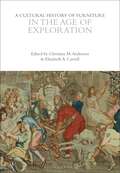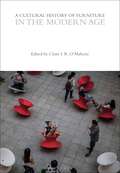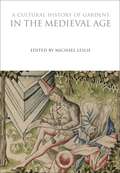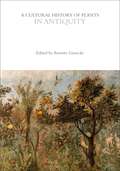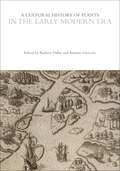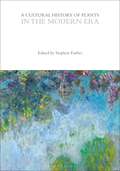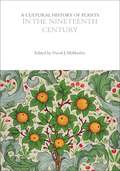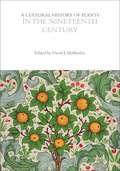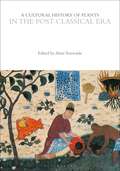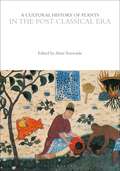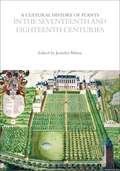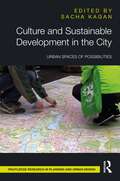- Table View
- List View
A Cultural History of Furniture in the Age of Exploration (The Cultural Histories Series)
by Professor Megan AldrichThe 16th and 17th centuries in Europe witnessed a significant paradigm shift. Rooted in medieval beliefs and preoccupations, the exploration so characteristic of the period stemmed from religious motives but came to be propelled by commerce and curiosity as Europeans increasingly engaged with the rest of the world. Interiors in both public and private spaces changed to reflect these cultural encounters and, with them, the furniture with which they were populated. Visually, furniture of this period displayed new designs, forms and materials. In its uses, it also mirrored developments in science, technology, government and social relationships as prints became more widely distributed, the Wunderkammer developed and there was religious strife and resistance to absolute monarchical rule.Drawing upon a wealth of visual and textual sources, this volume presents essays that examine key characteristics of the furniture of the period on the themes of Design and Motifs; Makers, Making, and Materials; Types and Uses; The Domestic Setting; The Public Setting; Exhibition and Display; Furniture and Architecture; Visual Representations; and Verbal Representations.
A Cultural History of Furniture in the Middle Ages and Renaissance (The Cultural Histories Series)
by Erin J. Campbell and Stephanie R. MillerThe Middle Ages were marked by dramatic social, economic, political, and religious changes. Diverse regional and local conditions, and varied social classes - including peasant, artisan, merchant, clergy, nobility, and rulers - resulted in differing needs for furniture. The social settings for furniture included official and private residences both grand and humble, churches and monasteries, and civic institutions, including places of governance and learning, such as municipal halls, guild halls, and colleges. This volume explores how furniture contributed to the social fabric within these varied spaces.The chronological range of this volume extends from the fall of the Roman Empire through to the early Renaissance, a period which exhibited a wide array of types, styles, and motifs, including Byzantine, Romanesque, Gothic, and Renaissance. Rural and regional styles of furniture are also considered, as well as techniques of furniture manufacture. Drawing upon a wealth of visual and textual sources, this volume presents essays that examine key characteristics of the furniture of the period on the themes of Design and Motifs; Makers, Making, and Materials; Types and Uses; The Domestic Setting; The Public Setting; Exhibition and Display; Furniture and Architecture; Visual Representations; and Verbal Representations.
A Cultural History of Furniture in the Middle Ages and Renaissance (The Cultural Histories Series)
The Middle Ages were marked by dramatic social, economic, political, and religious changes. Diverse regional and local conditions, and varied social classes - including peasant, artisan, merchant, clergy, nobility, and rulers - resulted in differing needs for furniture. The social settings for furniture included official and private residences both grand and humble, churches and monasteries, and civic institutions, including places of governance and learning, such as municipal halls, guild halls, and colleges. This volume explores how furniture contributed to the social fabric within these varied spaces.The chronological range of this volume extends from the fall of the Roman Empire through to the early Renaissance, a period which exhibited a wide array of types, styles, and motifs, including Byzantine, Romanesque, Gothic, and Renaissance. Rural and regional styles of furniture are also considered, as well as techniques of furniture manufacture. Drawing upon a wealth of visual and textual sources, this volume presents essays that examine key characteristics of the furniture of the period on the themes of Design and Motifs; Makers, Making, and Materials; Types and Uses; The Domestic Setting; The Public Setting; Exhibition and Display; Furniture and Architecture; Visual Representations; and Verbal Representations.
A Cultural History of Furniture in the Modern Age (The Cultural Histories Series)
by Claire I. R. O’MahonyFurniture is a unique witness to the transformations of private and public experience amidst the upheavals of the 20th century. How we work, rest and play are determined by the embodied encounter with furniture, defining and projecting a sense of identity and status, responding to and exemplifying contrasting social conditions, political and economic motivations, aesthetic predilections and debates. Assessing physical and archival evidence drawn from a spectrum of iconic and under-represented case studies, an international team of design historians collaborate in this volume to explore key methodological questions about how the production, consumption and mediation of furniture reveal shifting cultural habits and histories across diverse contexts amidst modernity. Drawing upon a wealth of visual and textual sources, this volume presents essays that examine key characteristics of the furniture of the period on the themes of Design and Motifs; Makers, Making, and Materials; Types and Uses; The Domestic Setting; The Public Setting; Exhibition and Display; Furniture and Architecture; Visual Representations; and Verbal Representations.
A Cultural History of Furniture in the Modern Age (The Cultural Histories Series)
Furniture is a unique witness to the transformations of private and public experience amidst the upheavals of the 20th century. How we work, rest and play are determined by the embodied encounter with furniture, defining and projecting a sense of identity and status, responding to and exemplifying contrasting social conditions, political and economic motivations, aesthetic predilections and debates. Assessing physical and archival evidence drawn from a spectrum of iconic and under-represented case studies, an international team of design historians collaborate in this volume to explore key methodological questions about how the production, consumption and mediation of furniture reveal shifting cultural habits and histories across diverse contexts amidst modernity. Drawing upon a wealth of visual and textual sources, this volume presents essays that examine key characteristics of the furniture of the period on the themes of Design and Motifs; Makers, Making, and Materials; Types and Uses; The Domestic Setting; The Public Setting; Exhibition and Display; Furniture and Architecture; Visual Representations; and Verbal Representations.
A Cultural History of Gardens in the Medieval Age (The Cultural Histories Series)
by Michael LeslieThe Middle Ages was a time of great upheaval - the period between the seventh and fourteenth centuries saw great social, political and economic change. The radically distinct cultures of the Christian West, Byzantium, Persian-influenced Islam, and al-Andalus resulted in different responses to the garden arts of antiquity and different attitudes to the natural world and its artful manipulation. Yet these cultures interacted and communicated, trading plants, myths and texts. By the fifteenth century the garden as a cultural phenomenon was immensely sophisticated and a vital element in the way society saw itself and its relation to nature.A Cultural History of Gardens in the Medieval Age presents an overview of the period with essays on issues of design, types of gardens, planting, use and reception, issues of meaning, verbal and visual representation of gardens, and the relationship of gardens to the larger landscape.
A Cultural History of Gardens in the Medieval Age (The Cultural Histories Series)
The Middle Ages was a time of great upheaval - the period between the seventh and fourteenth centuries saw great social, political and economic change. The radically distinct cultures of the Christian West, Byzantium, Persian-influenced Islam, and al-Andalus resulted in different responses to the garden arts of antiquity and different attitudes to the natural world and its artful manipulation. Yet these cultures interacted and communicated, trading plants, myths and texts. By the fifteenth century the garden as a cultural phenomenon was immensely sophisticated and a vital element in the way society saw itself and its relation to nature.A Cultural History of Gardens in the Medieval Age presents an overview of the period with essays on issues of design, types of gardens, planting, use and reception, issues of meaning, verbal and visual representation of gardens, and the relationship of gardens to the larger landscape.
A Cultural History of Plants in Antiquity (The Cultural Histories Series)
by Annette GieseckeA Cultural History of Plants in Antiquity covers the period from 10,000 BCE to 500 CE. This period witnessed the transition from hunter-gatherer subsistence to the practice of agriculture in Mesopotamia and elsewhere, and culminated in the fall of the Roman Empire, the end of the Han Dynasty in China, the rise of Byzantium, and the first flowering of Mayan civilization. Human uses for and understanding of plants drove cultural evolution and were inextricably bound to all aspects of cultural practice. The growth of botanical knowledge was fundamental to the development of agriculture, technology, medicine, and science, as well as to the birth of cities, the rise of religions and mythologies, and the creation of works of literature and art. The 6 volume set of the Cultural History of Plants presents the first comprehensive history of the uses and meanings of plants from prehistory to today. The themes covered in each volume are plants as staple foods; plants as luxury foods; trade and exploration; plant technology and science; plants and medicine; plants in culture; plants as natural ornaments; the representation of plants. Annette Giesecke is Professor of Classics at the University of Delaware, USA. Volume 1 in the Cultural History of Plants set.General Editors: Annette Giesecke, University of Delaware, USA, and David Mabberley, University of Oxford, UK.
A Cultural History of Plants in Antiquity (The Cultural Histories Series)
A Cultural History of Plants in Antiquity covers the period from 10,000 BCE to 500 CE. This period witnessed the transition from hunter-gatherer subsistence to the practice of agriculture in Mesopotamia and elsewhere, and culminated in the fall of the Roman Empire, the end of the Han Dynasty in China, the rise of Byzantium, and the first flowering of Mayan civilization. Human uses for and understanding of plants drove cultural evolution and were inextricably bound to all aspects of cultural practice. The growth of botanical knowledge was fundamental to the development of agriculture, technology, medicine, and science, as well as to the birth of cities, the rise of religions and mythologies, and the creation of works of literature and art. The 6 volume set of the Cultural History of Plants presents the first comprehensive history of the uses and meanings of plants from prehistory to today. The themes covered in each volume are plants as staple foods; plants as luxury foods; trade and exploration; plant technology and science; plants and medicine; plants in culture; plants as natural ornaments; the representation of plants. Annette Giesecke is Professor of Classics at the University of Delaware, USA. Volume 1 in the Cultural History of Plants set.General Editors: Annette Giesecke, University of Delaware, USA, and David Mabberley, University of Oxford, UK.
A Cultural History of Plants in the Early Modern Era (The Cultural Histories Series)
by Andrew Dalby and Annette GieseckeA Cultural History of Plants in the Early Modern Era covers the period from 1400 to 1650, a time of discovery and rediscovery, of experiment and innovation. Renaissance learning brought ancient knowledge to modern European consciousness whilst exploration placed all the continents in contact with one another. The dissemination of knowledge was further speeded by the spread of printing. New staples and spices, new botanical medicines, and new garden plants all catalysed agriculture, trade, and science. The great medical botanists of the period attempted no less than what Marlowe's Dr Faustus demanded - a book “wherein I might see all plants, herbs, and trees that grow upon the earth.” Human impact on plants and our botanical knowledge had irrevocably changed. The 6 volume set of the Cultural History of Plants presents the first comprehensive history of the uses and meanings of plants from prehistory to today. The themes covered in each volume are plants as staple foods; plants as luxury foods; trade and exploration; plant technology and science; plants and medicine; plants in culture; plants as natural ornaments; the representation of plants. Andrew Dalby is an independent scholar and writer, based in France. Annette Giesecke is Professor of Classics at the University of Delaware, USA. Volume 3 in the Cultural History of Plants set.General Editors: Annette Giesecke, University of Delaware, USA, and David Mabberley, University of Oxford, UK.
A Cultural History of Plants in the Early Modern Era (The Cultural Histories Series)
A Cultural History of Plants in the Early Modern Era covers the period from 1400 to 1650, a time of discovery and rediscovery, of experiment and innovation. Renaissance learning brought ancient knowledge to modern European consciousness whilst exploration placed all the continents in contact with one another. The dissemination of knowledge was further speeded by the spread of printing. New staples and spices, new botanical medicines, and new garden plants all catalysed agriculture, trade, and science. The great medical botanists of the period attempted no less than what Marlowe's Dr Faustus demanded - a book “wherein I might see all plants, herbs, and trees that grow upon the earth.” Human impact on plants and our botanical knowledge had irrevocably changed. The 6 volume set of the Cultural History of Plants presents the first comprehensive history of the uses and meanings of plants from prehistory to today. The themes covered in each volume are plants as staple foods; plants as luxury foods; trade and exploration; plant technology and science; plants and medicine; plants in culture; plants as natural ornaments; the representation of plants. Andrew Dalby is an independent scholar and writer, based in France. Annette Giesecke is Professor of Classics at the University of Delaware, USA. Volume 3 in the Cultural History of Plants set.General Editors: Annette Giesecke, University of Delaware, USA, and David Mabberley, University of Oxford, UK.
A Cultural History of Plants in the Modern Era (The Cultural Histories Series)
by Stephen ForbesA Cultural History of Plants in the Modern Era covers the period from 1920 to today - a time when population growth, industrialization, global trade, and consumerism have fundamentally reshaped our relationship with plants. Advances in agriculture, science, and technology have revolutionised the ways we feed ourselves, whilst urbanization and industrial processing have reduced our direct connection with living plants. At the same time, our understanding of both ecology and conservation have greatly increased and our appreciation of the meanings and aesthetics of plants continue to suffuse art and everyday culture. The modern era has witnessed a revolution in both the valuation and the destruction of the natural world - more than ever before, we understand that the vitality of our relationship with plants will shape our future. The 6 volume set of the Cultural History of Plants presents the first comprehensive history of the uses and meanings of plants from prehistory to today. The themes covered in each volume are plants as staple foods; plants as luxury foods; trade and exploration; plant technology and science; plants and medicine; plants in culture; plants as natural ornaments; the representation of plants.Stephen Forbes is an independent scholar and writer, based in Australia. Volume 6 in the Cultural History of Plants set.General Editors: Annette Giesecke, University of Delaware, USA, and David Mabberley, University of Oxford, UK.
A Cultural History of Plants in the Modern Era (The Cultural Histories Series)
A Cultural History of Plants in the Modern Era covers the period from 1920 to today - a time when population growth, industrialization, global trade, and consumerism have fundamentally reshaped our relationship with plants. Advances in agriculture, science, and technology have revolutionised the ways we feed ourselves, whilst urbanization and industrial processing have reduced our direct connection with living plants. At the same time, our understanding of both ecology and conservation have greatly increased and our appreciation of the meanings and aesthetics of plants continue to suffuse art and everyday culture. The modern era has witnessed a revolution in both the valuation and the destruction of the natural world - more than ever before, we understand that the vitality of our relationship with plants will shape our future. The 6 volume set of the Cultural History of Plants presents the first comprehensive history of the uses and meanings of plants from prehistory to today. The themes covered in each volume are plants as staple foods; plants as luxury foods; trade and exploration; plant technology and science; plants and medicine; plants in culture; plants as natural ornaments; the representation of plants.Stephen Forbes is an independent scholar and writer, based in Australia. Volume 6 in the Cultural History of Plants set.General Editors: Annette Giesecke, University of Delaware, USA, and David Mabberley, University of Oxford, UK.
A Cultural History of Plants in the Nineteenth Century (The Cultural Histories Series)
by David J. MabberleyA Cultural History of Plants in the Nineteenth Century covers the period from 1800 to 1920, a time of astonishing growth in industrialization, urbanization, migration, population growth, colonial possessions, and developments in scientific knowledge. As European modes of civilization and cultivation were exported worldwide, botanical study was revolutionized – through the work of Charles Darwin and many others – and the new science of biology was born, based on cells, nuclei and molecules. As Darwinism took hold, plants came to be seen as a way of thinking about the connectivity of nature and life itself. The 6 volume set of the Cultural History of Plants presents the first comprehensive history of the uses and meanings of plants from prehistory to today. The themes covered in each volume are plants as staple foods; plants as luxury foods; trade and exploration; plant technology and science; plants and medicine; plants in culture; plants as natural ornaments; the representation of plants. David Mabberley is Emeritus Fellow at Wadham College, University of Oxford, UK; Emeritus Professor at the University of Leiden, The Netherlands; and Adjunct Professor at Macquarie University, Australia. Volume 5 in the Cultural History of Plants set.General Editors: Annette Giesecke, University of Delaware, USA, and David Mabberley, University of Oxford, UK.
A Cultural History of Plants in the Nineteenth Century (The Cultural Histories Series)
A Cultural History of Plants in the Nineteenth Century covers the period from 1800 to 1920, a time of astonishing growth in industrialization, urbanization, migration, population growth, colonial possessions, and developments in scientific knowledge. As European modes of civilization and cultivation were exported worldwide, botanical study was revolutionized – through the work of Charles Darwin and many others – and the new science of biology was born, based on cells, nuclei and molecules. As Darwinism took hold, plants came to be seen as a way of thinking about the connectivity of nature and life itself. The 6 volume set of the Cultural History of Plants presents the first comprehensive history of the uses and meanings of plants from prehistory to today. The themes covered in each volume are plants as staple foods; plants as luxury foods; trade and exploration; plant technology and science; plants and medicine; plants in culture; plants as natural ornaments; the representation of plants. David Mabberley is Emeritus Fellow at Wadham College, University of Oxford, UK; Emeritus Professor at the University of Leiden, The Netherlands; and Adjunct Professor at Macquarie University, Australia. Volume 5 in the Cultural History of Plants set.General Editors: Annette Giesecke, University of Delaware, USA, and David Mabberley, University of Oxford, UK.
A Cultural History of Plants in the Post-Classical Era (The Cultural Histories Series)
by Alain TouwaideA Cultural History of Plants in the Post-Classical Era covers the period from 500 to 1400, ranging across northern and central Europe to the Mediterranean, and from the Byzantine and Arabic Empires to the Persian World, India, and China. This was an age of empires and fluctuating borders, presenting a changing mosaic of environments, populations, and cultural practices. Many of the ancient uses and meanings of plants were preserved, but these were overlaid with new developments in agriculture, landscapes, medicine, eating habits, and art. The 6 volume set of the Cultural History of Plants presents the first comprehensive history of the uses and meanings of plants from prehistory to today. The themes covered in each volume are plants as staple foods; plants as luxury foods; trade and exploration; plant technology and science; plants and medicine; plants in culture; plants as natural ornaments; the representation of plants. Alain Touwaide is Scientific Director at the Institute for the Preservation of Medical Traditions, Washington, D.C., USA. Volume 2 in the Cultural History of Plants set.General Editors: Annette Giesecke, University of Delaware, USA, and David Mabberley, University of Oxford, UK.
A Cultural History of Plants in the Post-Classical Era (The Cultural Histories Series)
A Cultural History of Plants in the Post-Classical Era covers the period from 500 to 1400, ranging across northern and central Europe to the Mediterranean, and from the Byzantine and Arabic Empires to the Persian World, India, and China. This was an age of empires and fluctuating borders, presenting a changing mosaic of environments, populations, and cultural practices. Many of the ancient uses and meanings of plants were preserved, but these were overlaid with new developments in agriculture, landscapes, medicine, eating habits, and art.The six-volume set of the Cultural History of Plants presents the first comprehensive history of the uses and meanings of plants from prehistory to today. The themes covered in each volume are plants as staple foods; plants as luxury foods; trade and exploration; plant technology and science; plants and medicine; plants in culture; plants as natural ornaments; the representation of plants.Alain Touwaide is Scientific Director at the Institute for the Preservation of Medical Traditions, Washington, D.C., USA.A Cultural History of Plants in the Post-Classical Era is the second volume in the six-volume set, A Cultural History of Plants, also available online as part of Bloomsbury Cultural History, a fully-searchable digital library (see www.bloomsburyculturalhistory.com).General Editors: Annette Giesecke, University of Delaware, USA, and David Mabberley, University of Oxford, UK.
A Cultural History of Plants in the Seventeenth and Eighteenth Centuries (The Cultural Histories Series)
by Jennifer MilamA Cultural History of Plants in the Seventeenth and Eighteenth Centuries covers the period from 1650 to 1800,a time of global exploration and the discovery of new species of plants and their potential uses. Trade routes were established which brought Europeans into direct contact with the plants and people of Asia, Oceania, Africa and the Americas. Foreign and exotic plants become objects of cultivation, collection, and display, whilst the applications of plants became central not only to naturalists, landowners, and gardeners but also to philosophers, artists, merchants, scientists, and rulers. As the Enlightenment took hold, the natural world became something to be grasped through reasoned understanding. The 6 volume set of the Cultural History of Plants presents the first comprehensive history of the uses and meanings of plants from prehistory to today. The themes covered in each volume are plants as staple foods; plants as luxury foods; trade and exploration; plant technology and science; plants and medicine; plants in culture; plants as natural ornaments; the representation of plants. Jennifer Milam is Pro Vice-Chancellor and Professor of Art History, University of Newcastle, Australia. Volume 4 in the Cultural History of Plants set.General Editors: Annette Giesecke, University of Delaware, USA, and David Mabberley, University of Oxford, UK.
A Cultural History of Plants in the Seventeenth and Eighteenth Centuries (The Cultural Histories Series)
A Cultural History of Plants in the Seventeenth and Eighteenth Centuries covers the period from 1650 to 1800,a time of global exploration and the discovery of new species of plants and their potential uses. Trade routes were established which brought Europeans into direct contact with the plants and people of Asia, Oceania, Africa and the Americas. Foreign and exotic plants become objects of cultivation, collection, and display, whilst the applications of plants became central not only to naturalists, landowners, and gardeners but also to philosophers, artists, merchants, scientists, and rulers. As the Enlightenment took hold, the natural world became something to be grasped through reasoned understanding. The 6 volume set of the Cultural History of Plants presents the first comprehensive history of the uses and meanings of plants from prehistory to today. The themes covered in each volume are plants as staple foods; plants as luxury foods; trade and exploration; plant technology and science; plants and medicine; plants in culture; plants as natural ornaments; the representation of plants. Jennifer Milam is Pro Vice-Chancellor and Professor of Art History, University of Newcastle, Australia. Volume 4 in the Cultural History of Plants set.General Editors: Annette Giesecke, University of Delaware, USA, and David Mabberley, University of Oxford, UK.
Cultural Landscapes of South Asia: Studies in Heritage Conservation and Management (Routledge Research in Landscape and Environmental Design)
by Kapila D. Silva Amita SinhaWinner of the Environmental Design Research Association's 2018 Achievement Award The pluralism of South Asia belies any singular reading of its heritage. In spite of this diversity, its cultural traditions retain certain attributes that are at their core South Asian—in their capacity to self‐organize, enact and reinvent cultural memories, and in their ability to retain an intimate connection with nature and landscape. This volume focuses on the notion of cultural landscape as a medium integrating multiple forms of heritage and points to a new paradigm for conservation practices in the South Asian context. Even though the construct of cultural landscape has been accepted as a category of heritage, its potent use in heritage management in general and within the South Asian context in particular has not been widely studied. The volume challenges the prevalent views of heritage management in South Asia that are entrenched in colonial legacies and contemporary global policy frameworks.
Cultural Landscapes of South Asia: Studies in Heritage Conservation and Management (Routledge Research in Landscape and Environmental Design)
by Kapila D. Silva Amita SinhaWinner of the Environmental Design Research Association's 2018 Achievement Award The pluralism of South Asia belies any singular reading of its heritage. In spite of this diversity, its cultural traditions retain certain attributes that are at their core South Asian—in their capacity to self‐organize, enact and reinvent cultural memories, and in their ability to retain an intimate connection with nature and landscape. This volume focuses on the notion of cultural landscape as a medium integrating multiple forms of heritage and points to a new paradigm for conservation practices in the South Asian context. Even though the construct of cultural landscape has been accepted as a category of heritage, its potent use in heritage management in general and within the South Asian context in particular has not been widely studied. The volume challenges the prevalent views of heritage management in South Asia that are entrenched in colonial legacies and contemporary global policy frameworks.
Culture and Sustainable Development in the City: Urban Spaces of Possibilities (Routledge Research in Planning and Urban Design)
by Sacha KaganThis book exposes the potential to advance a cultural approach to sustainable urban development. It explores urban "spaces of possibilities" and links them to the seized or missed opportunities for innovative forms of transversal partnerships throughout the city and of culturally sensitive urban policies.The call for sustainability brings with it challenges for which, in view of the urgency of social transformation, institutional innovations are necessary. Sustainable urban development will only succeed through creative impulses, experiments, trying out innovative ideas, and making alternatives visible, in particular through locally rooted urban initiatives, artistic actions, and social movements. Discussing many concrete examples from several years of empirical research in the cities of Hanover and Hamburg (Germany), Baltimore and Chicago (USA), Bangalore (India), St. Petersburg (Russia), Singapore, and Vancouver (Canada), the book connects urban spaces and their actors; looks at their guiding principles, strategies, and concrete practices; and identifies new levers, networks, and alliances. Readers will find in this book not only inspiring examples of culture in everyday life in the city but also explanations about the qualities that make local cultural initiatives especially full of potentials, and how they may translate into city-wide changes, engaging with the whole City as Space of Possibilities.The book will interest researchers and advanced students in the interdisciplinary fields of urban studies, sustainability science/sustainability research, cultural sciences, urban sociology, and sociology of the arts/cultural sociology; and those interested in the transdisciplinary collaborations between the arts, academia, and civil society.
Culture and Sustainable Development in the City: Urban Spaces of Possibilities (Routledge Research in Planning and Urban Design)
by Sacha KaganThis book exposes the potential to advance a cultural approach to sustainable urban development. It explores urban "spaces of possibilities" and links them to the seized or missed opportunities for innovative forms of transversal partnerships throughout the city and of culturally sensitive urban policies.The call for sustainability brings with it challenges for which, in view of the urgency of social transformation, institutional innovations are necessary. Sustainable urban development will only succeed through creative impulses, experiments, trying out innovative ideas, and making alternatives visible, in particular through locally rooted urban initiatives, artistic actions, and social movements. Discussing many concrete examples from several years of empirical research in the cities of Hanover and Hamburg (Germany), Baltimore and Chicago (USA), Bangalore (India), St. Petersburg (Russia), Singapore, and Vancouver (Canada), the book connects urban spaces and their actors; looks at their guiding principles, strategies, and concrete practices; and identifies new levers, networks, and alliances. Readers will find in this book not only inspiring examples of culture in everyday life in the city but also explanations about the qualities that make local cultural initiatives especially full of potentials, and how they may translate into city-wide changes, engaging with the whole City as Space of Possibilities.The book will interest researchers and advanced students in the interdisciplinary fields of urban studies, sustainability science/sustainability research, cultural sciences, urban sociology, and sociology of the arts/cultural sociology; and those interested in the transdisciplinary collaborations between the arts, academia, and civil society.
Culture, Community, and Development (Community Development Research and Practice Series)
by Rhonda Phillips Mark A. BrennanCulture is a living thing. In social settings, it is often used to represent entire ways of life, including rules, values, and expected behavior. Varying from nation to nation, neighborhood to neighborhood and beyond, even in the smallest localities, culture is a motivating factor in the creation of social identity and serves as a basis for creating cohesion and solidarity. This book explores the intersection of culture and community as a basis for locally and regionally based development by focusing on three core bodies of literature: theory, research, and practice. The first section, theory, uncovers some of the more relevant historical arguments, as well as more contemporary examinations. Continuing, the research section sheds light on some of the key concepts, variables, and relationships present in the limited study of culture in community development. Finally, the practice section brings together research and theory into applied examples from on the ground efforts. During a time where the interest to retain the uniqueness of local life, traditions, and culture is significantly increasing in community-based development, the authors offer a global exploration of the impacts of culturally based development with comparative analysis in countries such as Korea, Ireland, and the United States. A must-read for community development planners, policymakers, students, and researchers.
Culture, Community, and Development (Community Development Research and Practice Series)
by Rhonda Phillips Mark A. BrennanCulture is a living thing. In social settings, it is often used to represent entire ways of life, including rules, values, and expected behavior. Varying from nation to nation, neighborhood to neighborhood and beyond, even in the smallest localities, culture is a motivating factor in the creation of social identity and serves as a basis for creating cohesion and solidarity. This book explores the intersection of culture and community as a basis for locally and regionally based development by focusing on three core bodies of literature: theory, research, and practice. The first section, theory, uncovers some of the more relevant historical arguments, as well as more contemporary examinations. Continuing, the research section sheds light on some of the key concepts, variables, and relationships present in the limited study of culture in community development. Finally, the practice section brings together research and theory into applied examples from on the ground efforts. During a time where the interest to retain the uniqueness of local life, traditions, and culture is significantly increasing in community-based development, the authors offer a global exploration of the impacts of culturally based development with comparative analysis in countries such as Korea, Ireland, and the United States. A must-read for community development planners, policymakers, students, and researchers.
